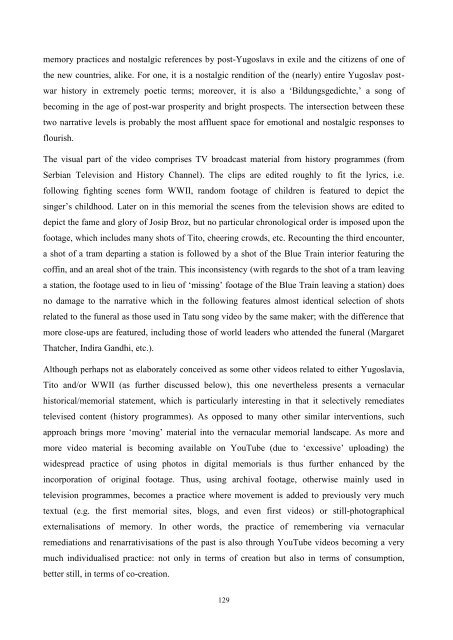UNIVERSITY OF NOVA GORICA GRADUATE SCHOOL ...
UNIVERSITY OF NOVA GORICA GRADUATE SCHOOL ...
UNIVERSITY OF NOVA GORICA GRADUATE SCHOOL ...
You also want an ePaper? Increase the reach of your titles
YUMPU automatically turns print PDFs into web optimized ePapers that Google loves.
memory practices and nostalgic references by post-Yugoslavs in exile and the citizens of one of<br />
the new countries, alike. For one, it is a nostalgic rendition of the (nearly) entire Yugoslav postwar<br />
history in extremely poetic terms; moreover, it is also a ‗Bildungsgedichte,‘ a song of<br />
becoming in the age of post-war prosperity and bright prospects. The intersection between these<br />
two narrative levels is probably the most affluent space for emotional and nostalgic responses to<br />
flourish.<br />
The visual part of the video comprises TV broadcast material from history programmes (from<br />
Serbian Television and History Channel). The clips are edited roughly to fit the lyrics, i.e.<br />
following fighting scenes form WWII, random footage of children is featured to depict the<br />
singer‘s childhood. Later on in this memorial the scenes from the television shows are edited to<br />
depict the fame and glory of Josip Broz, but no particular chronological order is imposed upon the<br />
footage, which includes many shots of Tito, cheering crowds, etc. Recounting the third encounter,<br />
a shot of a tram departing a station is followed by a shot of the Blue Train interior featuring the<br />
coffin, and an areal shot of the train. This inconsistency (with regards to the shot of a tram leaving<br />
a station, the footage used to in lieu of ‗missing‘ footage of the Blue Train leaving a station) does<br />
no damage to the narrative which in the following features almost identical selection of shots<br />
related to the funeral as those used in Tatu song video by the same maker; with the difference that<br />
more close-ups are featured, including those of world leaders who attended the funeral (Margaret<br />
Thatcher, Indira Gandhi, etc.).<br />
Although perhaps not as elaborately conceived as some other videos related to either Yugoslavia,<br />
Tito and/or WWII (as further discussed below), this one nevertheless presents a vernacular<br />
historical/memorial statement, which is particularly interesting in that it selectively remediates<br />
televised content (history programmes). As opposed to many other similar interventions, such<br />
approach brings more ‗moving‘ material into the vernacular memorial landscape. As more and<br />
more video material is becoming available on YouTube (due to ‗excessive‘ uploading) the<br />
widespread practice of using photos in digital memorials is thus further enhanced by the<br />
incorporation of original footage. Thus, using archival footage, otherwise mainly used in<br />
television programmes, becomes a practice where movement is added to previously very much<br />
textual (e.g. the first memorial sites, blogs, and even first videos) or still-photographical<br />
externalisations of memory. In other words, the practice of remembering via vernacular<br />
remediations and renarrativisations of the past is also through YouTube videos becoming a very<br />
much individualised practice: not only in terms of creation but also in terms of consumption,<br />
better still, in terms of co-creation.<br />
129

















